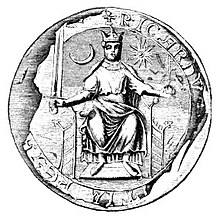
Back Günəş (heraldika) AZ Sonne (Heraldik) German Liste des meubles héraldiques#Soleil French שמש (סמל) HE Surya (lambang) ID Sole (araldica) Italian Солнце в геральдике Russian Сонце (геральдика) Ukrainian



A representation of the sun is used as a heraldic charge. The most usual form, often called sun in splendour or in his glory, consists of a round disc with the features of a human face surrounded by twelve or sixteen rays alternating wavy and straight.[2][3] The alternating straight and wavy rays are often said to represent the light and heat of the sun respectively.[4]
It was used as a badge by Edward II of England, and was later adopted by Edward IV following the appearance of a parhelion or "sun dog" before his victory at the Battle of Mortimer's Cross in 1461[3][5] (see also Battle of Mortimer's Cross#Parhelion). It also had significance in alchemy, and may be a symbol of the Roman deity Sol Invictus (Unconquered Sun).[6]
It is a common charge in the heraldry of many countries, regions and cities: e.g. the bearings of Armstrong family in Canada;[7] the Sun in Splendour appears superimposed on the Cross of St. George and behind the White Rose of York on the flag of the West Riding of Yorkshire; and on the arms of Banbury Town Council,[8] England. It also often appears as a rising sun as in the arms of East Devon District Council,[9] England, and as a demi sun as in the coat of Don McLean Aitchison,[10] Canada.
According to historian Diego Abad de Santillán, the Sun of May represents Inti, the Incan god of the sun, and thereby Inca culture.[11] It appears as a heraldic sun in the national flags of Argentina (1818) and Uruguay (1828) and Ecuador (1860), in the flags and shields of the Peru–Bolivian Confederation (1836–1839) and its component the Republic of South Peru, in the flag of Peru of 1822–1825, and in the current flag of the Peruvian Navy (1821).
- ^ English heraldic tradition of the early modern period associates the star and crescent design with Richard, with his victory over Isaac Komnenos of Cyprus in 1192, and with the arms of Portsmouth (Francis Wise A Letter to Dr Mead Concerning Some Antiquities in Berkshire, 1738, p. 18). Heraldic tradition also attributes a star-and-crescent badge to Richard (Charles Fox-Davies, A Complete Guide to Heraldry, 1909, p. 468).
- ^ James Parker, A glossary of terms used in heraldry. Accessed 13 December 2009
- ^ a b Dictionary of Vexillology. Accessed 13 December 2009
- ^ Fox-Davies, A.C., (1969) A complete guide to heraldry. Aylesbury: Thomas Nelson and Sons. p. 222.
- ^ Encyclopædia Britannica: Edward IV and the Alchemists[dead link]. Accessed 13 December 2009.
- ^ Banbury Faith Trail. Accessed 13 December 2009
- ^ "The Public Register of Arms, Flags and Badges of Canada". Governor General of Canada. Archived from the original on 16 June 2012.
- ^ "CIVIC HERALDRY OF ENGLAND AND WALES - THAMES VALLEY AND CHILTERNS". www.civicheraldry.co.uk. Retrieved 3 June 2024.
- ^ "CORNWALL AND WESSEX AREA". Civic Heraldry. Archived from the original on 20 November 2016.
- ^ "The Public Register of Arms, Flags and Badges of Canada". Governor General of Canada. Archived from the original on 16 June 2012.
- ^ Abad de Santillán, Diego (1965). Historia Argentina. Buenos Aires: TEA (Tipográfica Editora Argentina).